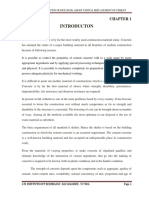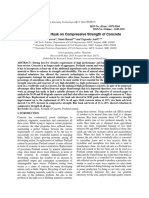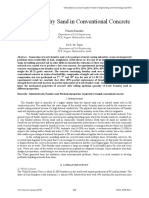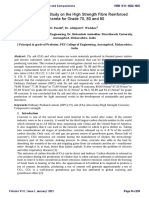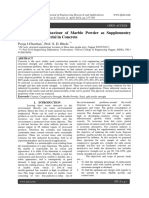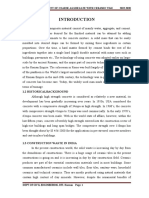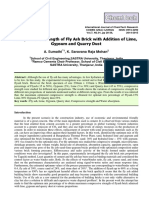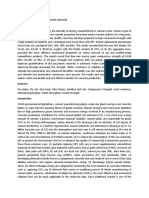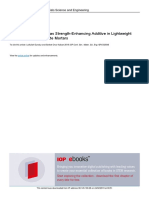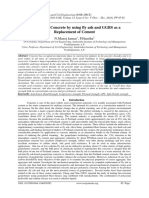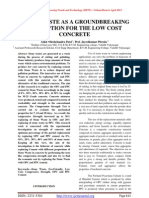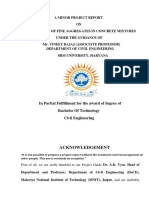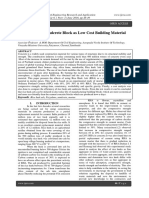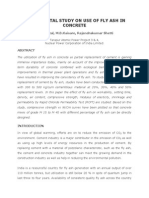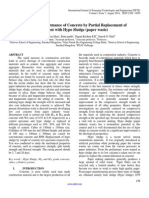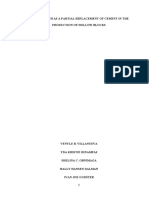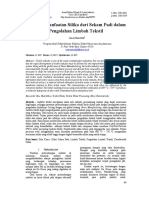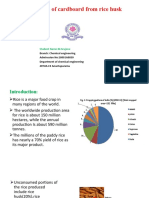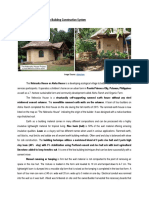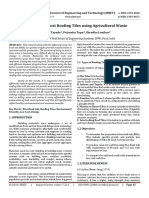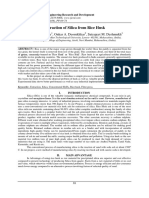Professional Documents
Culture Documents
ZG 31268271
ZG 31268271
Uploaded by
AJER JOURNALOriginal Description:
Original Title
Copyright
Available Formats
Share this document
Did you find this document useful?
Is this content inappropriate?
Report this DocumentCopyright:
Available Formats
ZG 31268271
ZG 31268271
Uploaded by
AJER JOURNALCopyright:
Available Formats
American Journal of Engineering Research (AJER)
2014
American Journal of Engineering Research (AJER) e-ISSN : 2320-0847 p-ISSN : 2320-0936 Volume-03, Issue-01, pp-268-271 www.ajer.org Research Paper Open Access
Properties of Concrete on Replacement of Coarse Aggregate and Cementitious Materials with Styfoam And Rice Husk Ash Respectively
Ananya Sheth1, Anirudh Goel2, B.H.Venkatram Pai3
1,2,3
Department of Civil Engineering, Manipal Institute of Technology / Manipal University, India
Abstract: - This paper reports an experimental investigation on the influence of Rice Husk Ash (RHA)and
Expanded Poly Styrene (EPS) on the mechanical properties and the properties of fresh concrete of the produced RHA and EPS blended concrete. EPS aggregates were used to replace coarse aggregates by volume with an aim to decrease the unit weight. Locally produced RHA was used to replace cement by its weight with an aim to increase workability. Mixture proportioning was performed to produce target strength of 65 MPa. Past researches regarding complete replacement of coarse aggregates with EPS aggregates have shown strength of less than 10 MPa. Hence, our aim is to achieve strength of 25-30 MPa thereby utilizing environmentally sustainable concrete in the rapidly developing low cost housing sectors of developing countries.
Keywords: environment, sustainable concrete, expanded polystyrene, rice husk ash, low cost housing,
concrete, 25 MPa, 4 more key words.
I.
INTRODUCTION
Medium weight concrete is the choice of designers owing to lighter and more economic structures. Medium weight concrete is produced by introducing air inside the concrete; either by using gassing and foaming agent or using lightweight aggregate such as natural aggregate (pumice, shale, slate) or industrial by-product (palm oil clinker, sintered fly ash) or plastic granules (Styrofoam or polymer materials). The high porosity of such industrial by-product and natural aggregates would cause adsorption of water and would prove disadvantageous in terms of shrinkage and permeability. Styrofoam is popularly used as a good thermal insulation material in building construction. Besides, it is widely used in the packaging industry especially as a damping agent to protect soft goods from vibrations and damage during transportation. It has no secondary use and is treated as a waste product. Its is difficult to recycle which as a whole is not a fundamental process in developing countries. We propose the use of Styrofoam cubes in concrete to replace by weight, a percentage of coarse aggregate (grit) with a purpose to make our concrete lighter. The Styrofoam aggregate has a closed cell structure consisting essentially of 98% air. Due to the porosity and buoyancy, the lightweight aggregates in fresh concrete tend to float on the concrete surface. Rice husk is an agro-by product which is produced in large quantities in agrarian countries. Approximately, 20 Kg of rice husk is obtained from 100 Kg of rice. Rice husk is constituted by 80% organic and 20% inorganic substances. When rice husk is combusted, the ash obtained can be termed Rice Husk Ash (RHA). It contains a high amount of amorphous phase content such as silicon dioxide which is the primary constituent of Portland cement. Therefore, RHA may be used as a constituent material in lime-pozzolana and/or a replacement for both cement as well as silica fumes. Concrete samples were synthesized by mixing ordinary Portland cement, sand and coarse aggregate (grit) where some part of grit and cement was replaced (by weight), with Styrofoam aggregates and RHA respectively. A comprehensive range of samples having various permutations of density and compressive strength were obtained by proportioning the replacements.
www.ajer.org
Page 268
American Journal of Engineering Research (AJER)
II. EXPERIMENTAL DETAIL
2.1 MATERIALS. 2.1.1 CEMENT. Ordinary Portland Cement - Grade 42
2013
2.1.1.1 CHEMICAL COMPOSITION. Silicon dioxide (SIO2) 21.00; Aluminium oxide (AL2O3) 5.30; Ferric oxide (FE2O3) 3.30; Calcium oxide (CAO) 65.60; Magnesium oxide (MGO) 1.10; Sulphur tioxide (SO3) 2.70; Loss of ignition (LOI) 0.90; Tricalcium silicate (C3S) 60.00; Dicalcium Silicate (C2S) 15.00; Tricalcium aluminate (C3A) 8.05; Tricalcium alumino ferrice (C4AF) 9.76. 2.1.1.2 PHYSICAL AND MECHANICAL PROPERTIES. Blain CM2/GR 3.250, Autoclave expantion 0.02, Initial setting time (VICAT) 105 minutes, Final setting time (VICAT) 135 minutes. 2.1.2 SAND. Fine sundried sand passing through 475 micron sieve was selected as the most appropriate to make a uniform and homogeneous binding matrix of the concrete to be produced. 2.1.3 COARSE AGGREGATE. The coarse aggregate selected were 20mm down sized crushed granite aggregates. 2.1.4 STYROFOAM AGGREGATE. The Styrofoam aggregate were 10 x 10 x 10 mm. cubes, cut from waste EPS (Expanded Polystyrene) sheets. 2.1.5 FLY ASH. Fly ash material solidifies while suspended in the exhaust gases and is collected by electrostatic precipitatorsor filter bags. Since the particles solidify while suspended in the exhaust gases, fly ash particles are generallyspherical in shape and range in size from 0.5 m to 100 m. They consist mostly of silicon dioxide (SiO2), which is present in two forms: amorphous, which is rounded and smooth, and crystalline, which is sharp, pointed and hazardous; aluminium oxide (Al2O3) and iron oxide (Fe2O3). Fly ashes are generally highly heterogeneous, consisting of a mixture of glassy particles with various identifiable crystalline phases such asquartz, mullite, and various iron oxides. For the concrete mix so produced we use Class F flyash. 2.1.6 RICE HUSK ASH (RHA). Rice milling generates husk as its by-product. About 78 % of weight is that of the rice grain, broken rice and bran. The remaining 22 % weight is husk. This husk is used as fuel in the rice mills to generate steam for the boiling process. Husk contains about 75 % organic volatile matter and the balance 25 % weight is converted into ash during the firing process. This is known as rice husk ash (RHA). RHA contains around 85 90 % amorphous silica. Therefore, for every 1000 kgs of paddy milled, about 220 kgs (22%) of husk is produced. This husk when combusted in boilers, generates about 55 kgs (25 %) of RHA. India is a major producer of rice, and the husk generated during milling is mostly used as a fuel in the boilers for processing paddy , producing energy through direct combustion and / or by gasification . About 20 million tonnes of RHA is produced annually in India. Generally, RHA is dumped in a landfill and thereby causes damage. The particle size of the cement is about 35 microns, which is why it can reduce the amount of cement in the concrete mix. RHA is a good super-pozzolana. There is a growing demand for fine amorphous silica in the production of special cement and concrete mixes, high performance concrete, high strength-low permeability concrete, for use in bridges, marine environments , nuclear power plants etc. This is where RHA finds an extensive use. 2.1.7 SUPER PLASTICIZER Poly carboxylate ether based super-plasticizer, algihyperplast-n claims to be a recommended product for batching plant mixed concrete of M50, M60 or higher grade concrete and where very high water reduction of 30-40% early and final strength is required or where colourless superplasticizer is required. It claims application
www.ajer.org
Page 269
American Journal of Engineering Research (AJER)
2013
in mix M60 where collapse slump is need at w/c of 0.3. It claims to improve cohesive properties of concrete, reduce segregation and bleeding, save cement through economy in mix design, allow early demoulding. Also speed up construction. Super plasticizer was added to the concrete mix in the ratio of 100-400ml for 50 kg of cement. Field trials are recommended to determine the optimum ratio. 2.2 MIX DESIGN AND PROPORTIONS. Table 1: Mixture proportions of the synthesized concrete. W/C RATIO FLY ASH CEMENT FA 0.3 0.6875 1 1.32 Table 2: Mix and replacement proportions.
Mix. No. RHA Replacement by weight of the total cementitious material. 10 % 10 % 10 % 20 % 20 % 30 % STYRO FOAM Replace ment by volume of CA. 20 % 25 % 30 % 20 % 25 % 30 % WATER (mL) CEMEN T (g) FINE AGGREG ATE (g) COARS E AGGRE GATE (g) 5600 5250 4550 5600 5250 4550 FLY ASH (g) RHA (g) STYRO FOAM (g)
CA 5.28
C11 C12 C13 C21 C22 C33
1260 1470 1260 1260 1260 1470
1450 1450 1450 1280 1280 1120
1600 1600 1600 1600 1600 1600
900 900 900 750 750 700
260 260 260 520 520 780
16.65 20.80 29.10 16.65 20.80 29.10
A fixed amount of super plasticizer i.e. 7ml per 1kg of cementitious material was added. After that, it was tested for the fresh concrete properties of workability (the vee-bee test) and then moulded into cubical specimens of dimensions 15X15X15cm and tested to the simple compressive strength, water absorption by immersion. The tests had been carried through with ages of 7 days with curing in humid chamber.
III.
RESULT
3.1 WORKABILITY. The workability, measured in VB degrees is shown in Table 3. The results show that higher amounts of RHA replacement give a very high flow mix which causes segregation and the cement sand matrix settles down causing a failure to set and harden. Table 3: Workability, measured in VB Degrees. C12 C13 C21 17 5 6
Mix. No. VB-Degrees (s)
C11 19
C22 17
C33 10
3.2 WATER ABSORPTION. The results indicate that higher substitution amounts results in lower water absorption values, this occurs due to the fact that RHA is finer than cement. Adding 10% of RHA to the concrete, a reduction of 38.7% in water absorption is observed, but the presence of styrofoam results in a certain higher percentage of water retention because the water is filled in the voids of the styrofoam so used. 3.3 SIMPLE COMPRESSIVE STRENGTH. The compressive strength is shown in Table 4. The addition of RHA caused an increment in the compressive strength due to the capacity of the pozzolana to fix the calcium hydroxide; generated during the hydration of cement. All samples which contained RHA showed increased compressive strength. However, the addition of styrofoam reduced the strength of the concrete. Greater percentage replacement of styrofoam rendered lesser strength owing to the inherent lower compressive strength of the polymer as compared to granite aggregates. Micro-cracks were developed after the hydration process near the styrofoam cement paste joints.
www.ajer.org
Page 270
American Journal of Engineering Research (AJER)
Mix. No. Compressive Strength (MPa) C11 26.55 Table 4: Simple Compressive Strength. C12 C13 C21 20.55 23.55 20 C22 18.2 C33 15.55
2013
IV.
CONCLUSION
The use of RHA in civil construction, besides reducing the environmental pollutants factors, may bring several improvements for the concrete characteristics. With the addition of RHA to concrete, a decreasing in water absorption was verified. According to the results of compressive strength test, all the replacement degrees of RHA researched showed an increase in the compressive strength to a particular level of replacement, but decreased if replaced to a higher degree. Greater surface area of the aggregate provides a larger area for bonding contact with the cement paste. Therefore, the strength of the concrete matrix will be higher. A smaller sized aggregate would yield greater surface area and hence would provide more surface for coating with binders. Thus, the usage of smaller size aggregates of styrofoam is preferable. Moreover, due to the structure of the Styrofoam cubes, the compressive strength at the corners was observed to be stronger and the faces notably remained soft. The highest compressive strength was obtained using minimum RHA content with the minimum Styrofoam content of size roughly 10 cubic mm. However, all the Styrofoam concrete series exhibited lower strength compared to the standard concrete mixture referring to the available literature. The concrete mixes under consideration produced strength in the range of 17-26 MPa at 7-days which is beyond the minimum requirement for structural lightweight applications, therefore this series is economical, lighter in weight and suitable for structural use.
ACKNOWLEDGEMENTS
We would like to acknowledge the faculty and staff of Manipal Institute of Technologys Material Testing Laboratory and Civil Engineering Laboratory for allowing us to conduct the experiments and use their facility for the purpose of this paper. We would also like to thank the staff of the library for allowing us to borrow from their large database of books and journal papers.
REFERENCES
A reference list MUST be included using the following information as a guide. Only cited text references are included. Each reference is referred to in the text by a number enclosed in a square bracket (i.e., [3]). References must be numbered and ordered according to where they are first mentioned in the paper, NOT alphabetically. Journal Papers: [1] V.I.E Ajiwe, C.A Okeke, F.C Akigwe, A preliminary study of manufacture of cement from rice husk ash, Bioresource Technology ,ELSEVIER, Volume 73,Issue 1,May 2000,37-39. [2] Raoul Jauberthie, Frank Rendell, Seni Tamba, Ibrahima Khalil Cisse, Properties of Cement rice husk mixture, Construction and building Materials, ELSEVIER, Volume 17, Issue 4, June 2003, 239-243. [3] Muhammad Shoaib Ismail, A.M. Waliuddin, Effect of Rice husk ash on high strength concrete, Construction and building Materials, ELSEVIER, Volume 10, Issue 7, October 1996, 521-526. [4] European Union Brite EuRam III, A rational mix design method for lightweight aggregate concrete using typical UK materials, EuroLightCon, Document BE96-3942/R5, January 2000. [5] Standard practice for selecting proportions for structural lightweight concrete, ACI 211.2-81. [6] Irving Kett, Engineered Concrete: Mix Design and Test Methods, Second edition, New Developments in Portland Cement Concrete (PCC) Technology, 182-184. [7] Kevin J. Simons, Affordabe Lightweight High Performance Concrete (ALWHPC) Expanding the envelope of concrete mix design, University of Nebraska Lincoln. Web data dases: [8] www.ricehuskash.com/publications.htm [9] www.ricehuskash.com/details.htm [10] http://www.lightconcrete.com/images/LightConcrete.pdf
www.ajer.org
Page 271
You might also like
- Construction and Building Materials: Valeria Corinaldesi, Giacomo Moriconi, Tarun R. NaikDocument5 pagesConstruction and Building Materials: Valeria Corinaldesi, Giacomo Moriconi, Tarun R. NaikShekharNo ratings yet
- India - A Study On Use of Rice Husk Ash in Concrete Project Report - Dhaval - 020515Document64 pagesIndia - A Study On Use of Rice Husk Ash in Concrete Project Report - Dhaval - 020515Narayan Singhania55% (11)
- Greener Concrete Using Recycled Materials: by Tarun R. NaikDocument5 pagesGreener Concrete Using Recycled Materials: by Tarun R. NaikAiman HakimNo ratings yet
- Marble Waste Use in Concrete 111Document20 pagesMarble Waste Use in Concrete 111mohd waseemNo ratings yet
- 7-An Experimental Investigation On Concrete Paver Block by UsingDocument11 pages7-An Experimental Investigation On Concrete Paver Block by UsinglafryNo ratings yet
- Effective Utilization of Rice Husk Ash by Partial Replacement of CementDocument43 pagesEffective Utilization of Rice Husk Ash by Partial Replacement of CementSharathBanakar50% (2)
- Use of Waste Material in ConcreteDocument56 pagesUse of Waste Material in Concretemanoj588No ratings yet
- Effect of Rice Husk On Compressive Strength of Concrete: Naveen, Sumit Bansal and Yogender AntilDocument7 pagesEffect of Rice Husk On Compressive Strength of Concrete: Naveen, Sumit Bansal and Yogender AntilShanthakumar NivoshanNo ratings yet
- Rice Husk Ash As A Partial Replacement of Cement in High Strength Concrete Containing Micro SilicaDocument19 pagesRice Husk Ash As A Partial Replacement of Cement in High Strength Concrete Containing Micro SilicaLoraene Dela TorreNo ratings yet
- HyposludgeDocument7 pagesHyposludgeSanyogita MathaneNo ratings yet
- Eng-Green Concrete Efficient and Eco-Friendly-Chirag GargDocument6 pagesEng-Green Concrete Efficient and Eco-Friendly-Chirag GargImpact JournalsNo ratings yet
- Effect of Unprocessed Rice Husk Ash As A Cementitious Material in Concrete PDFDocument7 pagesEffect of Unprocessed Rice Husk Ash As A Cementitious Material in Concrete PDFIAEME PublicationNo ratings yet
- Synergistic Effect On Ternary Blended Cementitious SystemDocument30 pagesSynergistic Effect On Ternary Blended Cementitious SystemEditor IJTSRDNo ratings yet
- Feasibility and Need of Use of Waste Marble Powder in Concrete ProductionDocument4 pagesFeasibility and Need of Use of Waste Marble Powder in Concrete ProductionAjithNo ratings yet
- Use of Foundry Sand in Conventional Concrete: Department of Civil Engineering PCE, Nagpur, Maharashtra, IndiaDocument6 pagesUse of Foundry Sand in Conventional Concrete: Department of Civil Engineering PCE, Nagpur, Maharashtra, IndiaPRAKNo ratings yet
- IntoDocument21 pagesIntoKARE YESWANTH RAJNo ratings yet
- Chapter 01Document10 pagesChapter 01Venkatram PrabhuNo ratings yet
- 821 PDFDocument9 pages821 PDFarifNo ratings yet
- Experimental Investigation On High Performance Concrete With Partial Replacement of Fine Aggregate by Foundry Sand With Cement by Mineral AdmixturesDocument6 pagesExperimental Investigation On High Performance Concrete With Partial Replacement of Fine Aggregate by Foundry Sand With Cement by Mineral Admixturesபுருஷோத்தமன் சரவணன்No ratings yet
- The International Journal of Engineering and Science (The IJES)Document4 pagesThe International Journal of Engineering and Science (The IJES)theijesNo ratings yet
- Strength Behavior of Sisal Fibre Concrete With Fine Construction Waste AggregateDocument8 pagesStrength Behavior of Sisal Fibre Concrete With Fine Construction Waste AggregatevempadareddyNo ratings yet
- A Comparative Study On The High Strength Fibre ReinforcedDocument7 pagesA Comparative Study On The High Strength Fibre ReinforcedDr-Rahul PanditNo ratings yet
- Experimental Study On Pollution Control ConcreteDocument9 pagesExperimental Study On Pollution Control ConcreteInternational Journal of Application or Innovation in Engineering & ManagementNo ratings yet
- BJ044377381 PDFDocument5 pagesBJ044377381 PDFmaniNo ratings yet
- 1.1 Concrete: Partial Replacement of Coarse Aggregate With Ceramic Tile 2019-2020Document25 pages1.1 Concrete: Partial Replacement of Coarse Aggregate With Ceramic Tile 2019-2020Naveen S100% (2)
- Fly Ash Bricks Paper PDFDocument9 pagesFly Ash Bricks Paper PDFMohan KumarNo ratings yet
- Research MethodologyDocument19 pagesResearch MethodologyAbiodun AmusatNo ratings yet
- IJETR032903Document4 pagesIJETR032903erpublicationNo ratings yet
- Tittle: Pozzolana As Non OPC Binder MaterialsDocument8 pagesTittle: Pozzolana As Non OPC Binder MaterialsVIMAL MAURYANo ratings yet
- Incorporating Bottom Ash in Roller Compacted Concrete For Composite PavementsDocument11 pagesIncorporating Bottom Ash in Roller Compacted Concrete For Composite PavementsSunil VaishnavNo ratings yet
- Use of Rice Husk Ash As Strength-Enhancing Additive in Lightweight Cementitious Composite MortarsDocument12 pagesUse of Rice Husk Ash As Strength-Enhancing Additive in Lightweight Cementitious Composite MortarsFolorunsho AyomideNo ratings yet
- A Study On Effect of Fly Ash and Glass Powder On The Compressive Strength and Permeability of ConcreteDocument23 pagesA Study On Effect of Fly Ash and Glass Powder On The Compressive Strength and Permeability of ConcreteArul RajNo ratings yet
- Zaouai IRECEDocument5 pagesZaouai IRECEismail douidiNo ratings yet
- GPC Fa & GGBSDocument8 pagesGPC Fa & GGBSdeepaky6ce802No ratings yet
- Stone Waste As A Groundbreaking Conception For The Low Cost ConcreteDocument7 pagesStone Waste As A Groundbreaking Conception For The Low Cost ConcreteseventhsensegroupNo ratings yet
- Rice Husk Ash-Lime Blended Building BricksDocument8 pagesRice Husk Ash-Lime Blended Building BricksMelissa Feliciano100% (1)
- Project CivilDocument38 pagesProject CivilJatin SarohaNo ratings yet
- Partial Replacement of Cement With Hypo Sludge PDFDocument7 pagesPartial Replacement of Cement With Hypo Sludge PDFBhushan ParalkarNo ratings yet
- Aatif Project 1Document6 pagesAatif Project 1jack dowsonNo ratings yet
- Performance Evaluation of Green Mortar Comprising Ceramic Waste As Cement and Fine Aggregates ReplacementDocument7 pagesPerformance Evaluation of Green Mortar Comprising Ceramic Waste As Cement and Fine Aggregates ReplacementSAMANT RANANo ratings yet
- Rice Husk Ash Sandcrete Block As Low Cost Building Material: S.P.SangeethaDocument4 pagesRice Husk Ash Sandcrete Block As Low Cost Building Material: S.P.SangeethaMirza AfrianNo ratings yet
- I J O E R A I A: Nternational Ournal F Ngineering Esearch ND Ndustrial PplicationsDocument13 pagesI J O E R A I A: Nternational Ournal F Ngineering Esearch ND Ndustrial Pplicationsstructure123No ratings yet
- To Study The Partial Replacement of Cement by GGBS & RHA and Natural Sand by Quarry Sand in ConcreteDocument9 pagesTo Study The Partial Replacement of Cement by GGBS & RHA and Natural Sand by Quarry Sand in Concreteபுருஷோத்தமன் சரவணன்No ratings yet
- Study of Structural Performance and Durability of Concrete by Partial Replacement of Cement With Hypo Sludge (Paper Waste)Document5 pagesStudy of Structural Performance and Durability of Concrete by Partial Replacement of Cement With Hypo Sludge (Paper Waste)SivarajSivaNo ratings yet
- High Performance Concrete Using Quaternary BlendDocument5 pagesHigh Performance Concrete Using Quaternary BlendIJIRAENo ratings yet
- Effect of Guinea Corn Husk Ash As Partial Replacement For Cement in ConcreteDocument6 pagesEffect of Guinea Corn Husk Ash As Partial Replacement For Cement in ConcreteInternational Organization of Scientific Research (IOSR)No ratings yet
- Experimental Study On Rice Husk Ash in Concrete by Partial ReplacementDocument9 pagesExperimental Study On Rice Husk Ash in Concrete by Partial ReplacementvenkateshNo ratings yet
- Fly Ash BrickDocument19 pagesFly Ash BrickSuraj PrajapatiNo ratings yet
- Reactive Powder ConcreteDocument28 pagesReactive Powder ConcreteMolly JoseNo ratings yet
- Ground Granulated Blast Furnace Slag (Ggbs or GGBFS) and Fly Ash (Fa) in Concrete - A Study ReportDocument5 pagesGround Granulated Blast Furnace Slag (Ggbs or GGBFS) and Fly Ash (Fa) in Concrete - A Study ReportOM BIHARI SINGHNo ratings yet
- Amit MittalDocument22 pagesAmit MittalVincent VivekNo ratings yet
- Structural Performance of Concrete by Partial Replacement of Cement With Hypo Sludge (Paper Waste)Document7 pagesStructural Performance of Concrete by Partial Replacement of Cement With Hypo Sludge (Paper Waste)ijeteeditorNo ratings yet
- Impact Properties of Geopolymer Based Extrudates Incorporated With y Ash and PVA Short FiberDocument14 pagesImpact Properties of Geopolymer Based Extrudates Incorporated With y Ash and PVA Short FiberDerLorenaNo ratings yet
- Partial Replacement of ConcreteDocument12 pagesPartial Replacement of ConcreteGbenge JoshuaNo ratings yet
- Chapter-1: 1.1 GeneralDocument57 pagesChapter-1: 1.1 Generalkundanam venkateshNo ratings yet
- Ceramic WasteDocument6 pagesCeramic WasteShahab SadqpurNo ratings yet
- Guided By: S. Ramesh M.E Project Members: S.Anguselvan R.Syedkhaja Amrudeen R.Shankar GuruDocument23 pagesGuided By: S. Ramesh M.E Project Members: S.Anguselvan R.Syedkhaja Amrudeen R.Shankar GuruFazalur RahmanNo ratings yet
- Comparative Study of Fly Ash Bricks Containing Very Fine Fly Ash With Standard BricksDocument4 pagesComparative Study of Fly Ash Bricks Containing Very Fine Fly Ash With Standard BricksSarthakNo ratings yet
- Advances in Materials Science for Environmental and Energy Technologies VIFrom EverandAdvances in Materials Science for Environmental and Energy Technologies VITatsuki OhjiNo ratings yet
- Silica From Rice HusksDocument2 pagesSilica From Rice HusksLouanne dizonNo ratings yet
- Rice Husk Ash As A Partial Replacement of Cement in The Production of Hollow BlocksDocument15 pagesRice Husk Ash As A Partial Replacement of Cement in The Production of Hollow BlocksShelina ObnimagaNo ratings yet
- Effect On High Grade Concrete Due To Partial Replacement of Rice Hush Ash and Steel FiberDocument7 pagesEffect On High Grade Concrete Due To Partial Replacement of Rice Hush Ash and Steel FiberEditor IJTSRDNo ratings yet
- JMMM 2020 Jurnal MaterialDocument6 pagesJMMM 2020 Jurnal MaterialErnandafajarNo ratings yet
- Structural Properties of Rice Husk and Sawdust Composite BricksDocument28 pagesStructural Properties of Rice Husk and Sawdust Composite BricksAbijithNo ratings yet
- Chapter 1 5Document66 pagesChapter 1 5Dosirt VisdaNo ratings yet
- Commercial Uses of SugercaneDocument27 pagesCommercial Uses of SugercaneAisha AshrafNo ratings yet
- Ecc563 HaziqDocument14 pagesEcc563 HaziqhaziqNo ratings yet
- Juan Sumulong Memorial Junior College Taytay, Rizal S.Y. 2018-2019Document59 pagesJuan Sumulong Memorial Junior College Taytay, Rizal S.Y. 2018-2019Jehnn BenitoNo ratings yet
- Carbonized Rice Hull vs. Rice Hull As Partial Cement Alternates in Hollow Blocks: A Comparative StudyDocument37 pagesCarbonized Rice Hull vs. Rice Hull As Partial Cement Alternates in Hollow Blocks: A Comparative StudySuzaku KururugiNo ratings yet
- DPS FD Stem Eng.4Document36 pagesDPS FD Stem Eng.4rajc recioNo ratings yet
- Mor 2016Document23 pagesMor 2016Hassan DMNo ratings yet
- Germany - 100607 Patent For Manufacturing White Rice Husk AshDocument31 pagesGermany - 100607 Patent For Manufacturing White Rice Husk AshNarayan SinghaniaNo ratings yet
- Kajian Pemanfaatan Silika Dari Sekam Padi Dalam Pengolahan Limbah TekstilDocument6 pagesKajian Pemanfaatan Silika Dari Sekam Padi Dalam Pengolahan Limbah TekstilFaldy SyafarNo ratings yet
- Production of Cardboard From Rice HuskDocument12 pagesProduction of Cardboard From Rice HuskVarshi RaagaNo ratings yet
- Biomaterials in Construction IndustryDocument28 pagesBiomaterials in Construction IndustryAntara SablokNo ratings yet
- Organic Agriculture Gr11 - Module6.finalDocument14 pagesOrganic Agriculture Gr11 - Module6.finalJam Hamil AblaoNo ratings yet
- RiceDocument5 pagesRiceSoobian AhmedNo ratings yet
- Building Technology 5 - Rammed EarthDocument2 pagesBuilding Technology 5 - Rammed EarthLailanie TreyesNo ratings yet
- A Review Study On Precipitated Silica and Activated Carbon From Rice Husk 2157 7048.1000156 PDFDocument7 pagesA Review Study On Precipitated Silica and Activated Carbon From Rice Husk 2157 7048.1000156 PDFanon_432216275No ratings yet
- Angkor Bio Cogen ProjectDocument17 pagesAngkor Bio Cogen ProjectWorkshop on Enhancing the Regional Distribution of CDM Projects in Asia and the Pacific, 6-7 Sep 2011, Kathmandu, NepalNo ratings yet
- Possible Uses For Waste Rice Hulls in Building Materials and OtherDocument37 pagesPossible Uses For Waste Rice Hulls in Building Materials and OtherReshan VidurangaNo ratings yet
- Rice Husk Based Power PlantsDocument21 pagesRice Husk Based Power PlantsMohan Ananth67% (3)
- Principles and Methods of Rice MillingDocument12 pagesPrinciples and Methods of Rice MillingMary - Ann Andal100% (1)
- Chapter 1 5Document77 pagesChapter 1 5Dis DoodNo ratings yet
- Design of Low Cost Roofing Tiles Using Agricultural WasteDocument4 pagesDesign of Low Cost Roofing Tiles Using Agricultural WasteBirkure AjayNo ratings yet
- Gr4 Rice-Husk Chapter-2 FinalDocument2 pagesGr4 Rice-Husk Chapter-2 FinalBoaz BalmonteNo ratings yet
- Effect of Rice Husk Ash On Properties of ConcreteDocument4 pagesEffect of Rice Husk Ash On Properties of ConcreteEduardo Fernando Alarcon PrincipeNo ratings yet
- H12326974 PDFDocument6 pagesH12326974 PDFYuliantari YuliantariNo ratings yet





